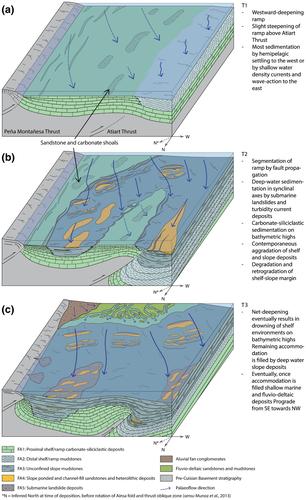当前位置:
X-MOL 学术
›
Basin Res.
›
论文详情
Our official English website, www.x-mol.net, welcomes your
feedback! (Note: you will need to create a separate account there.)
Initiation and evolution of an epicontinental shelf‐slope margin in an actively contracting deep‐water basin: The Eocene Aínsa Basin, southern Pyrenees (Spain)
Basin Research ( IF 2.8 ) Pub Date : 2024-07-23 , DOI: 10.1111/bre.12884 Ashley J. M. Ayckbourne 1 , Rhodri M. Jerrett 1 , Matthew P. Watkinson 2 , Miquel Poyatos‐Moré 3 , Ian A. Kane 1 , Stephen Covey‐Crump 1 , Kevin G. Taylor 1
Basin Research ( IF 2.8 ) Pub Date : 2024-07-23 , DOI: 10.1111/bre.12884 Ashley J. M. Ayckbourne 1 , Rhodri M. Jerrett 1 , Matthew P. Watkinson 2 , Miquel Poyatos‐Moré 3 , Ian A. Kane 1 , Stephen Covey‐Crump 1 , Kevin G. Taylor 1
Affiliation

|
The shelf‐slope margin is a geomorphic zone with a change in gradient between subaqueous shelves and slopes, which extends towards the submarine basin‐floor. It is important because it partitions distinct sedimentary and biogenic processes between the shallow and deep‐water realms. The initiation of a shelf‐slope profile from pre‐existing conditions, and the evolution of shelf margins in space and time has been the focus of numerous studies, particularly from seismic data sets on passive margins, although markedly less‐so from active tectonic settings. This study documents the initiation and evolution of a shelf‐slope margin in the well‐studied Eocene Aínsa Basin (Spanish Pyrenees) through the segmentation of a mixed carbonate‐siliciclastic ramp via contractional tectonics and differential subsidence. The basinward propagation of a series of thrusts through the ramp allowed the maintenance of shallow‐water, predominantly carbonate sedimentation on their uplifted hanging wall anticlines. Conversely, the deepened foot wall synclines became muddy slope environments, and their axes became the main loci of siliciclastic turbidity current bypass and deposition. The deflection of turbidity currents around uplifted areas towards the synclinal lows allowed for the continuation of carbonate production at the bathymetric highs, which kept pace with subsidence. The interface between shallow‐ and deep‐water sedimentation (i.e. the shelf‐slope margin) was an erosional and composite submarine scarp surface generated by several phases of large‐scale mass wasting of the aggrading shelf carbonates, and healing by onlap of slope turbidites against the scarp. Continued thrust propagation and basin deepening led to the progressive headward degradation of the surfaces, resulting in an apparent retrogradation of the shelf‐slope margin and onlapping slope deposits. This model for the tectonically controlled conversion of a submarine ramp into a shelf‐slope profile contrasts with conventional models that consider shelf‐slope margins to be inherently progradational after initiation. This study also challenges the notion that large‐scale degradational surfaces and thick successions of submarine landslides are inherently diagnostic of canyons and their fill.
中文翻译:

活跃收缩的深水盆地陆表陆架斜坡边缘的起始和演化:始新世艾因萨盆地,比利牛斯山脉南部(西班牙)
陆架坡缘是水下陆架与陆坡之间坡度变化的地貌带,向海底盆底延伸。它很重要,因为它将浅水区和深水区之间不同的沉积和生物成因过程分开。从预先存在的条件开始形成陆架斜坡剖面,以及陆架边缘在空间和时间上的演化一直是众多研究的焦点,特别是来自被动边缘地震数据集的研究,尽管来自主动构造环境的研究明显较少。本研究通过收缩构造和差异沉降对混合碳酸盐-硅质碎屑坡道进行分割,记录了经过充分研究的始新世艾因萨盆地(西班牙比利牛斯山脉)陆架斜坡边缘的起始和演化。一系列逆冲穿过斜坡向盆地传播,使得浅水区得以维持,在其隆起的上盘背斜上主要是碳酸盐沉积。反之,加深的下盘向斜则成为泥质斜坡环境,其轴线成为硅质碎屑浊流绕流和沉积的主要场所。隆起区域周围的浊流向向斜低点偏转,使得在测深高点处碳酸盐的生产得以继续,这与沉降的速度保持同步。浅水和深水沉积物之间的界面(即陆架斜坡边缘)是一个侵蚀性的复合海底陡坡面,是由沉积的陆架碳酸盐岩的大规模大量消耗和斜坡浊积岩对陆架的覆盖而愈合的几个阶段产生的。悬崖。 持续的逆冲传播和盆地加深导致地表逐渐向源头退化,导致陆架斜坡边缘和上覆斜坡沉积物明显退化。这种由构造控制将海底坡道转变为陆架斜坡剖面的模型与传统模型形成鲜明对比,传统模型认为陆架斜坡边缘在启动后本质上是渐进的。这项研究还挑战了这样一种观念,即大规模退化表面和厚厚的海底滑坡本质上是峡谷及其填充物的诊断因素。
更新日期:2024-07-23
中文翻译:

活跃收缩的深水盆地陆表陆架斜坡边缘的起始和演化:始新世艾因萨盆地,比利牛斯山脉南部(西班牙)
陆架坡缘是水下陆架与陆坡之间坡度变化的地貌带,向海底盆底延伸。它很重要,因为它将浅水区和深水区之间不同的沉积和生物成因过程分开。从预先存在的条件开始形成陆架斜坡剖面,以及陆架边缘在空间和时间上的演化一直是众多研究的焦点,特别是来自被动边缘地震数据集的研究,尽管来自主动构造环境的研究明显较少。本研究通过收缩构造和差异沉降对混合碳酸盐-硅质碎屑坡道进行分割,记录了经过充分研究的始新世艾因萨盆地(西班牙比利牛斯山脉)陆架斜坡边缘的起始和演化。一系列逆冲穿过斜坡向盆地传播,使得浅水区得以维持,在其隆起的上盘背斜上主要是碳酸盐沉积。反之,加深的下盘向斜则成为泥质斜坡环境,其轴线成为硅质碎屑浊流绕流和沉积的主要场所。隆起区域周围的浊流向向斜低点偏转,使得在测深高点处碳酸盐的生产得以继续,这与沉降的速度保持同步。浅水和深水沉积物之间的界面(即陆架斜坡边缘)是一个侵蚀性的复合海底陡坡面,是由沉积的陆架碳酸盐岩的大规模大量消耗和斜坡浊积岩对陆架的覆盖而愈合的几个阶段产生的。悬崖。 持续的逆冲传播和盆地加深导致地表逐渐向源头退化,导致陆架斜坡边缘和上覆斜坡沉积物明显退化。这种由构造控制将海底坡道转变为陆架斜坡剖面的模型与传统模型形成鲜明对比,传统模型认为陆架斜坡边缘在启动后本质上是渐进的。这项研究还挑战了这样一种观念,即大规模退化表面和厚厚的海底滑坡本质上是峡谷及其填充物的诊断因素。






























 京公网安备 11010802027423号
京公网安备 11010802027423号